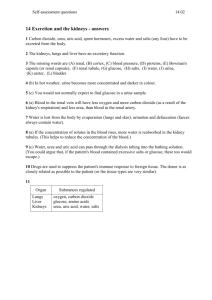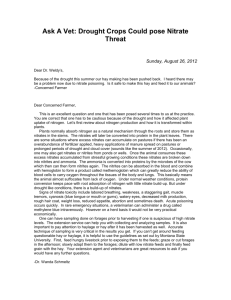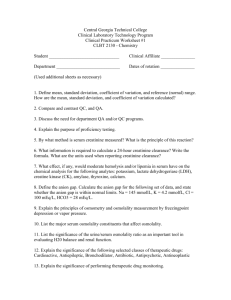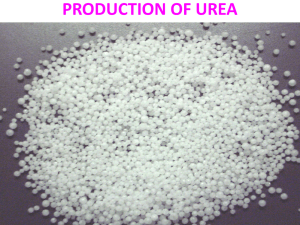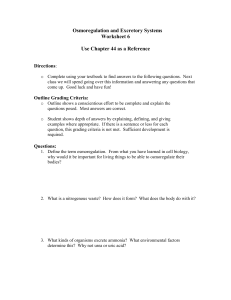Document 13359662
advertisement
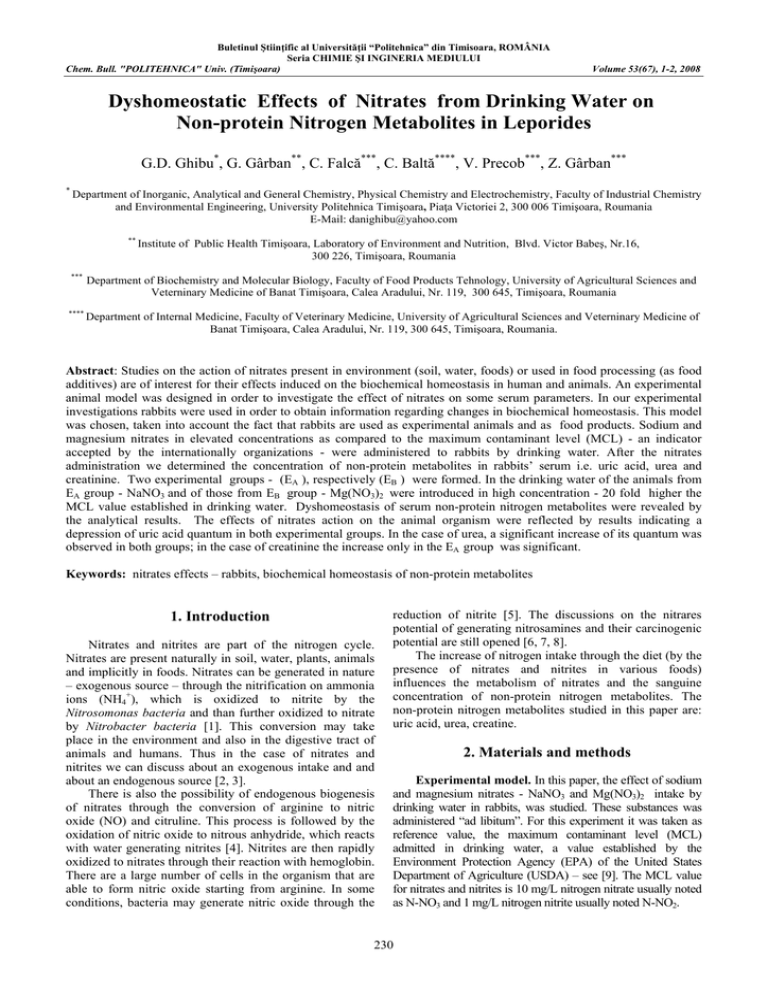
Buletinul Ştiinţific al Universităţii “Politehnica” din Timisoara, ROMÂNIA Seria CHIMIE ŞI INGINERIA MEDIULUI Chem. Bull. "POLITEHNICA" Univ. (Timişoara) Volume 53(67), 1-2, 2008 Dyshomeostatic Effects of Nitrates from Drinking Water on Non-protein Nitrogen Metabolites in Leporides G.D. Ghibu*, G. Gârban**, C. Falcă***, C. Baltă****, V. Precob***, Z. Gârban*** * Department of Inorganic, Analytical and General Chemistry, Physical Chemistry and Electrochemistry, Faculty of Industrial Chemistry and Environmental Engineering, University Politehnica Timişoara, Piaţa Victoriei 2, 300 006 Timişoara, Roumania E-Mail: danighibu@yahoo.com ** Institute of Public Health Timişoara, Laboratory of Environment and Nutrition, Blvd. Victor Babeş, Nr.16, 300 226, Timişoara, Roumania *** Department of Biochemistry and Molecular Biology, Faculty of Food Products Tehnology, University of Agricultural Sciences and Veterninary Medicine of Banat Timişoara, Calea Aradului, Nr. 119, 300 645, Timişoara, Roumania **** Department of Internal Medicine, Faculty of Veterinary Medicine, University of Agricultural Sciences and Veterninary Medicine of Banat Timişoara, Calea Aradului, Nr. 119, 300 645, Timişoara, Roumania. Abstract: Studies on the action of nitrates present in environment (soil, water, foods) or used in food processing (as food additives) are of interest for their effects induced on the biochemical homeostasis in human and animals. An experimental animal model was designed in order to investigate the effect of nitrates on some serum parameters. In our experimental investigations rabbits were used in order to obtain information regarding changes in biochemical homeostasis. This model was chosen, taken into account the fact that rabbits are used as experimental animals and as food products. Sodium and magnesium nitrates in elevated concentrations as compared to the maximum contaminant level (MCL) - an indicator accepted by the internationally organizations - were administered to rabbits by drinking water. After the nitrates administration we determined the concentration of non-protein metabolites in rabbits’ serum i.e. uric acid, urea and creatinine. Two experimental groups - (EA ), respectively (EB ) were formed. In the drinking water of the animals from EA group - NaNO3 and of those from EB group - Mg(NO3)2 were introduced in high concentration - 20 fold higher the MCL value established in drinking water. Dyshomeostasis of serum non-protein nitrogen metabolites were revealed by the analytical results. The effects of nitrates action on the animal organism were reflected by results indicating a depression of uric acid quantum in both experimental groups. In the case of urea, a significant increase of its quantum was observed in both groups; in the case of creatinine the increase only in the EA group was significant. B Keywords: nitrates effects – rabbits, biochemical homeostasis of non-protein metabolites 1. Introduction Nitrates and nitrites are part of the nitrogen cycle. Nitrates are present naturally in soil, water, plants, animals and implicitly in foods. Nitrates can be generated in nature – exogenous source – through the nitrification on ammonia ions (NH4+), which is oxidized to nitrite by the Nitrosomonas bacteria and than further oxidized to nitrate by Nitrobacter bacteria [1]. This conversion may take place in the environment and also in the digestive tract of animals and humans. Thus in the case of nitrates and nitrites we can discuss about an exogenous intake and and about an endogenous source [2, 3]. There is also the possibility of endogenous biogenesis of nitrates through the conversion of arginine to nitric oxide (NO) and citruline. This process is followed by the oxidation of nitric oxide to nitrous anhydride, which reacts with water generating nitrites [4]. Nitrites are then rapidly oxidized to nitrates through their reaction with hemoglobin. There are a large number of cells in the organism that are able to form nitric oxide starting from arginine. In some conditions, bacteria may generate nitric oxide through the reduction of nitrite [5]. The discussions on the nitrares potential of generating nitrosamines and their carcinogenic potential are still opened [6, 7, 8]. The increase of nitrogen intake through the diet (by the presence of nitrates and nitrites in various foods) influences the metabolism of nitrates and the sanguine concentration of non-protein nitrogen metabolites. The non-protein nitrogen metabolites studied in this paper are: uric acid, urea, creatine. 2. Materials and methods Experimental model. In this paper, the effect of sodium and magnesium nitrates - NaNO3 and Mg(NO3)2 intake by drinking water in rabbits, was studied. These substances was administered “ad libitum”. For this experiment it was taken as reference value, the maximum contaminant level (MCL) admitted in drinking water, a value established by the Environment Protection Agency (EPA) of the United States Department of Agriculture (USDA) – see [9]. The MCL value for nitrates and nitrites is 10 mg/L nitrogen nitrate usually noted as N-NO3 and 1 mg/L nitrogen nitrite usually noted N-NO2. 230 Chem. Bull. "POLITEHNICA" Univ. (Timişoara) Volume 53(67), 1-2, 2008 This study was performed on rabbits (Oryctolagus cuniculus) with the age of 4 weeks and the average weight of 700 ± 25 g. The rabbits were included in 2 two experimental groups (EA and EB). Each group comprised 5 rabbits (3 males and 2 females). The rabbits were fed with VivaBio, a granulated fodder for rabbits, produced by Freeman S.R.L. The fodder contained 14.94% protein, 2.86% fat and 8.51% cellulose. Animals of control group received drinking water from the same source with that used to prepare the nitrates solutions. The animals of EA group received a sodium nitrate (NaNO3) solution with a concentration equivalent to 20 x MCL for nitrate in water. Animal of EB group received a magnesium nitrate Mg(NO)3 - solution with a concentration of 20 x MCL established for nitrite in drinking water. The magnesium nitrate used in the preparation of the solution presented crystallized water molecules in his structure - Mg(NO)3•6H20. Before the beginning of the experiment, a quarantine period of 10 days was kept. In this period it was observed the health status and the rabbits were accommodated with the experimental laboratory environment and with the diet consisting of granulated fodder based on alfalfa. After the quarantine, the experiment has started and the duration time was 20 days. Blood samples were obtained at the beginning and at the end of the experiment. Venipuncture was made after a preliminary narcosis with acepromazine maleate (1 mg/kg) witch has a tranquilizing and also a vasodilatatory effect. The election place for the bleeding procedure was the auricular vein. The blood had been collected in 7 ml gradated vacuumtainers, the collected blood quantity being 3 ml. The experiments respected the standards of animals protection required in scientific and experimental means, standards mentioned in O.G. nr. 37/2002 [10]. Biochemical investigations. Uric acid, urea and creatinine concentration were determined in each serum samples obtained from control (C) and from experimental groups (EA şi EB). In all the situations, the analytical determinations were preceded by the calibration of the apparatus. For further information regarding the bioanalytical investigation see [11, 12]. Uric acid from blood serum was dosed through a spectrophotometrical method based on the enzymatic reaction with uricase. In reaction, uric acid is converted by uricase in allantoin CO2 and H2O2. In the presence of a phenol-derivate, namely 3,5-dichlor-2-hydroxybenzensulfonic acid disodium salt (DHBS) and of 4-aminoantipyrine a quinine is formed which can be determined by spectophotometric means. The determination is made at the wavelength of 520 nm. Urea from blood serum was determined by the means of UV spectrophotometry through an enzymatic method. In reaction, urea is hydrolyzed in the presence of urease to NH3 and CO2. The ammonia produced in the reaction combines with 2-oxoglutarate and NADH in the presence of glutamate dehydrogenase to yield glutamate and NAD+. The NADH/NAD+ reaction produce a change in absorbance at the wavelength 340 nm, which correlates with the concentration of urea nitrogen in the sample. Serum creatinine was determined through a colorimetric method with sodium picrate (Jaffé method). Creatinine forms with sodium picrate a colored complex containing ionic B B B bonds. The rate of formation of the colored complex is proportional to the creatinine concentration. The colored complex is determined at the wavelength of 492 nm. Total serum proteins were determined by the biuret method. Cupric ions in alkaline solutions react with the peptides bonds to produce a violet colored complex. The absorbance of the complex at 546 nm is directly proportional to the concentration of protein in the sample. Statistical analysis. Mean values ( X) and standard deviation (SD) were determined for each parameter obtained. Also, ΔX was calculated, from the difference between the initial and final values of each parameters. For analytical data P value was calculated. 3. Results and discussion The uric acid results from the purinic nucleobases oxidation. The main metabolic pathway of uric acid biogenesis is from xanthine which may be formed from adenine, and more often from guanine present in nucleic acids [13]. Thus the metabolites of purinic nucleobases (i.e.: adenine, guanine) lead in the end to the formation of uric acid (fig.1). Adenine adenase hipoxantin- Hipoxantine oxidase xantinoxidase Guanine Uric acid guanase Figure 1. Biogenesis of uric acid Plasma levels of uric acid are higher in males than in females [12]. High levels of uric acid are found in renal failure, lithiasis and leucosis. Low levels of uric acid are found in polyarthritis and hepatic failure. The normal values of uric acid in rabbit is 1,0 - 4,2 mg/dL – according to Falcă [14] and 2,47mg/dL – according to Zabulyte [15]. Data regarding biochemical homeostasis of uric acid in the studied animal groups are presented in table 1. TABLE 1. Homeostatic variations of uric acid in blood serum Specification Initial Final UM mg/dL mg/dL ΔX EA n 5 5 X ± SD 1.13 ± 0.56 0.80 ± 0.26 - 0.33 EB n 5 5 X ± SD 0.86 ± 0.05 0.77 ± 0.20 - 0.09 One can observe that the initial serum values of uric acid are relatively near, this aspect reflecting the species characteristic and especially of those of the studied animal group (average values). Related to these values, in the table are given the final values. One can remark that in both cases there are non-significant differences in average values (ΔX). More marked differences (ΔX = - 0.33) were found in the animals to which NaNO3 was administrated through drinking water, underlining the fact that NO3effects is enhanced by the presence of Na ions. Also, it can be hypothesized that the lower value of the difference in EB 231 B Chem. Bull. "POLITEHNICA" Univ. (Timişoara) Volume 53(67), 1-2, 2008 as compared with EA is due to the fact that Mg ions has an important role in the stabilization of the deoxyribonucleic acid macromolecule. Thus magnesium can influence the quantum of purinic nucleobases metabolites and through that it can influence the uric acid metabolism. Blood urea is directly dependent on the nitrogen catabolism. In the process of amino acid deamination, ammonia is produced. The development of toxic levels of ammonia in blood is prevented by the conversion of ammonia to urea. The biochemical reactions which convert ammonium into urea are known as urea cycle [16]. This cycle, in the case of mammalians, takes places in liver. Urea in blood is expressed as “blood urea nitrogen” (BUN), which is a measure of the amount of nitrogen in the blood that comes from urea. The protein dietary intake and the health status of the liver are the main factors that influence the value of urea in humans and animals [17]. The reference level of BUN in healthy rabbits is: 13-30 mg/dL [18]. The BUN value is reported as mg/dL and the value of urea is reported as mmol/L. To convert from mg/dL of blood urea nitrogen to mmol/L of urea, one divides by 2.8 (each molecule of urea having 2 nitrogen, each of molar mass 14 g/mol). Data regarding the investigations made on urea are given in table 2, following in parallel the evolution of both experimental groups (EA and EB). B TABLE 2. Homeostatic variations of urea in blood serum EA Specification UM Initial value mg/dL n 5 Final value mg/dL 5 ΔX **P < 0,05 ; *P < 0.01 X ± SD 25.25 ± 10.56 35.66 ± 2.98** + 10.41 Specification UM Initial value Final value ΔX ** P < 0.05 mg/dL mg/dL EA n 5 5 X ± SD 0.78 ± 0.17 0.92 ± 0.08** + 0.14 EB n 5 5 X ± SD 0.70 ± 0.11 0.77 ± 0.05 + 0.07 The results presented in table 3 showed more increased differences (ΔX) in both groups, but significant differences are only in experimental group EA. The effects on creatinine must be correlated with the modification of creatine and creatin phosphate through the metabolic processes. In this situation it can be estimated that the magnesium ions intervene, together with calcium ions, in the phospho-calcic metabolism. Thus the low influence of Mg(NO3)2 might be also explained by the role of magnesium in this metabolism. High values of serum creatinine are found in: myopathies, polymyositis, renal failure, diabetes, hyperthyroidism while low values of creatinine are specific in chronic renal failure. Similar data on biochemical homeostasis, consecutive to sodium nitrate, have been found in rats by Zabulyte et al. [15]. In another study that approached the problem of NaNO3 administration on experimental groups of 5 rabbits there was revealed that uric acid values in serum increase together with those of creatinine and urea [20]. EB n 5 X ± SD 23.00 ± 3.60 5 32.50 ± 2.88* 4. Conclusions + 9.50 The effects on urea underline significant differences in EA group (+10.41) and in EB group (+9.50). The increased values of urea in blood are at the origin of various diseases: nephropathies, chronical hepatopathies, renal failure, etc. Also Increased values of urea were found also in hyperproteic diet, in intoxication and in some parasitizes (e.g. coccydiose). Low values of urea in blood are found in: icterus, cirrhosis, low protein diet [14]. Serum and urinary creatinine levels depend directly on the subject muscle mass and shows little response to dietary changes [19]. Creatinine is derived from the nonenzymatic dehydration of creatine in skeletal muscle. Since the serum creatinine concentration is a direct reflection of muscle mass, the serum level is higher in males than in females. The quantity of creatinine per body mass unit is constant, therefore the rate of creatinine production is constant [13]. As a result of the constant ratio of creatinine production, the concentration of plasmatic creatinine is very stable, it’s variation being less than 10% per day at healthy subjects. The reference value for creatinine in healthy rabbits is 0.5 - 2.6 mg/dL [11]. Regarding the modification of serum creatinine quantum data are given in table 3. B TABLE 3. Homeostatic variations of serum creatinine The administration of NaNO3 and Mg(NO3)2 in drinking water, in the case of the discussed animal experimental model (leporides), alters the homeostasis of bood non-protein nitrogen metabolites (uric acid, urea, creatinine), as a consequence of the pathobiochemical effects at renal and hepatic level. Determinations regarding uric acid concentration in blood serum revealed the depression of its quantum. This depression was more accentuated in the case of NaNO3 administration. The effects of nitrates on serum urea are revealed by an increase of its quantum with significant values in both experimental groups. Homeostatic variations in serum creatinine were also found. A significant increase of its quantum was observed only in the case of NaNO3 administration. REFERENCES 1. Bhaskar K.V., Charyulu P.B.B.N. - Effect of environmental factors on nitrifying bacteria isolated from the rhizosphere of Setaria italica (L.) Beauv, African Journal of Biotechnology, 2005, 4(10), pp. 1145-1146. 2. Terblanche A. P. S. - Health hazards of nitrate in drinking water, Water S.A. 1991, 17(1), pp. 77-82. 3. Ghibu G.D., Balint M., Gârban Z. - Investigation concerning the effect induced by the presence of nitrites and nitrates in the feed of rabbits, pp. 113116, Proceedings of the 14th symposium on analytical and environmental problems (Ed. Zoltan Galbacs), SZAB, Szeged, Hungary, 2007. 232 Chem. Bull. "POLITEHNICA" Univ. (Timişoara) Volume 53(67), 1-2, 2008 4. Gârban Z. Xenobiochimie: Tratat comprehensiv, Vol IV, Editura Eurobit, Timişoara, 2004. 5. Wishnok J.S., Tannenbaum S.R., Tamir S., deRojas-Walker T. Endogenous formation of nitrate, pp. 151-179, In: Proc. of the International Workshop on Health Aspects of Nitrate and its Metabolites (Particularly Nitrite), Bilthoven, The Netherlands, 8-10 Nov.1994, Council of Europe Press, Strasbourg, 1995. 6. Kleinjans J.C., Albering H.J., Marx A., van Maanen J.M., van Agen B., ten Hoor F., Swaen G.M., Mertens P.L. - Nitrate contamination of drinking water: evaluation of genotoxic risk in human populations, Environ. Health Perspect., 1991, 94, pp. 189-193. 7. Gilli G., Corrao G., Favilli S. - Concentrations of nitrates in drinking water and incidence of gastric carcinomas : first descriptive of the Piemonte region, Italy. Sci. Total Environ., 1994, 34, pp. 35-48. 8. Gârban Z., Gârban Gabriela, Ghibu G.D. – The importance of deoxyribonucleic acid adducts in biochemistry and xenobiochemistry, Revista de Chimie, 2007, 58(5), pp. 456-460. 9.***http://www.epa.gov/OGWDW/contaminants/dw_contamfs/nitrates. 10. *** Ordonanţa Guvernului nr. 37/2002 pentru protecţia animalelor folosite în scopuri ştiinţifice sau în alte scopuri experimentale, Monitorul Oficial, România, 2002. 11. Kaneko J.J., Clinical biochemistry of domestic animals, Academic Press, New-York, 1989. 12. Kaplan L.A., Pesce A.J. - Clinical Chemistry: Theory, Analysis, Correlation, 3rd ed., Mosby - Year Book Inc, St. Louis, Missouri, 1996. 13. Devlin T.M. (ed) Textbook of biochemistry with clinical correlations, 5th ed., Wiley-Liss, NewYork, 2002. 14. Falca C., Semiologie medicala veterinara, vol2, Editura CosmopolitanArt, Timişoara, 2004. 15. Zabulyte D., Uleckiene S., Kalibatas J., Paltanaviciene A., Jascaniniene N., Stosik M., Experimental studies on effect of sodium fluoride and nitrate on biochemical parameters in rats, Bull. Vet. Inst. Pulawy, 2007, 51, pp. 79-82. 16. Mathews C.K., van Holde K.E., Ahern K.G. – Biochemistry, 3rd ed, Cummings, San Francisco, 2000. 17. Mogoş G., Sitcai N., Toxicologie clinică: Fiziopatologie, diagnostic, tratament, Vol.1., Editura Medicală, Bucureşti, 1988. 18.***http://www.medirabbit.com/EN/Hematology/Parameters/BUN_valu es.htm, 2008. 19. Perrone R.D., Madias N.E., Levey A.S, - Serum creatinine as an index of renal function: new insights into old concepts, Clin. Chem., 1992, 38, pp. 1933-1953. 20. Shour A., El-Aziz I., Kerrit A., Al-Agha M., Effects of oral administration of nitrate on serum glucose, some lipids, and non-protein nitrogen constituents, Islamic University Journal, 1999, 7(1), pp. 1-13. 233
